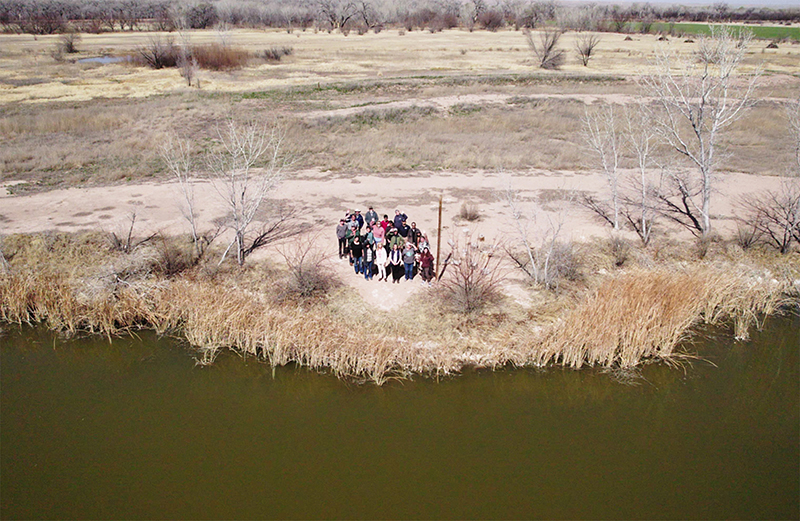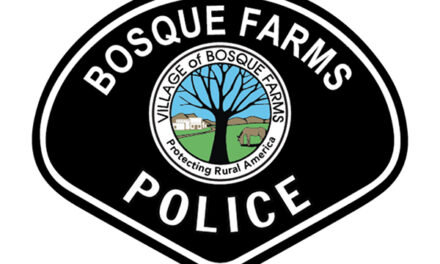Almost a year to the day after the 2022 Big Hole Fire, more than three dozen ecologists, soil specialists, hydrologists, biologists and experts concerned with climate change and soil and water conservation spent two days at a local wildlife conservation area to help begin planning restoration work which can serve as a template for the community and the future.
The fire scorched 75 percent of the 97-acre Whitfield Wildlife Conservation Area, destroying many of the old-growth trees on the property, such as the massive cottonwood known as the Owl Tree.
Earlier this year, Whitfield was the site of the Valencia Soil and Water Conservation District’s USDA Southwest Climate Hub, which brought together experts to discuss how to best restore the property. VSWCD owns and operates the conservation area.

Submitted photo
Experts in ecology, hydrology, soil conservation and more met earlier this year at the Whitfield Wildlife Conservation Area to begin planning restoration efforts for the acreage burned in last year’s Big Hole Fire.
VSWCD Director Andrew Hautzinger said the workshop provided a solid platform for the district to visit with major partners about the project.
“One of the big take homes from the workshop, is it’s really important to realize a significant percentage of preserve have responded positively to the fire,” Hautzinger said. “The grasses have come back with some really nice native domination. We think that the actual act of restoration may be more appropriate on 20 to 25 percent of the preserve.”
In addition to restoration, the plantings at Whitfield will also need to mitigate fire at the same time, he said.
Teresa Smith de Cherif, VSWCD board of supervisors vice chairwoman, said replanting will also help keep invasive species from returning to the conservation area.
“You want to restore to get ahead of the undesirable, non-native (plants), and you want to restore to make your location less likely to burn again,” Smith de Cherif said.
Although some areas burned have rebounded, the ecosystem of Whitfield, which abuts the Rio Grande bosque, is not fire adapted.
“It’s flood adapted so the consequences for that is for the old timers, the ancient trees, that aren’t coming back in our lifetime. That is the real loss,” Hautzinger said.
Efforts to replant and restore Whitfield also supports the community engagement the area has built, he added.
“There’s nothing like a generational commitment and a family planting a tree, and we’ve seen it with parents who brought their kids here and say, ‘I planted this one when I was 15.’”
In addition, restoration efforts will allow the district to create an environment that is climate resilient.
“We can restore some canopy out here, with desert willow and cottonwoods that are flood adapted, but also bring in some other species from further south that are used to the heat that will have a greater chance of increasing the biodiversity and be better suited for the area,” Hautzinger said. “For instance, the velvet ash can provide a similar canopy that cottonwoods can but it has heat resistance and drought tolerance.”
A final plant list and plan for the restoration is still in the works, the director said, with help from workshop experts, and will include plants that will thrive in the area and be adjusted to the local soils.
“Another of the big take homes is you have to get used to the site conditions. Soils in the Rio Grande flood plain are highly variable. I have a patch of sandy soil here, have a patch of clay there,” Hautzinger said. “As the list is developed it will be very much a scientific endeavor. It will be data driven.”
The ultimate outcome of the restoration plan that is developed for Whitfield speaks to the core of the mission of the district — soil and water conservation.
“This can be a model for the future for anyone in the community. The best practices to solve a problem means you have the actual biology to go with it.
“What are your plant decisions? Where do you put those plants?” Hautzinger said. “We want to have a deliverable out of this, which is a usable, updated plant list available to the community that has a climate component and a fire behavior component.”
Julia M. Dendinger began working at the VCNB in 2006. She covers Valencia County government, Belen Consolidated Schools and the village of Bosque Farms. She is a member of the Society of Professional Journalists Rio Grande chapter’s board of directors.
















